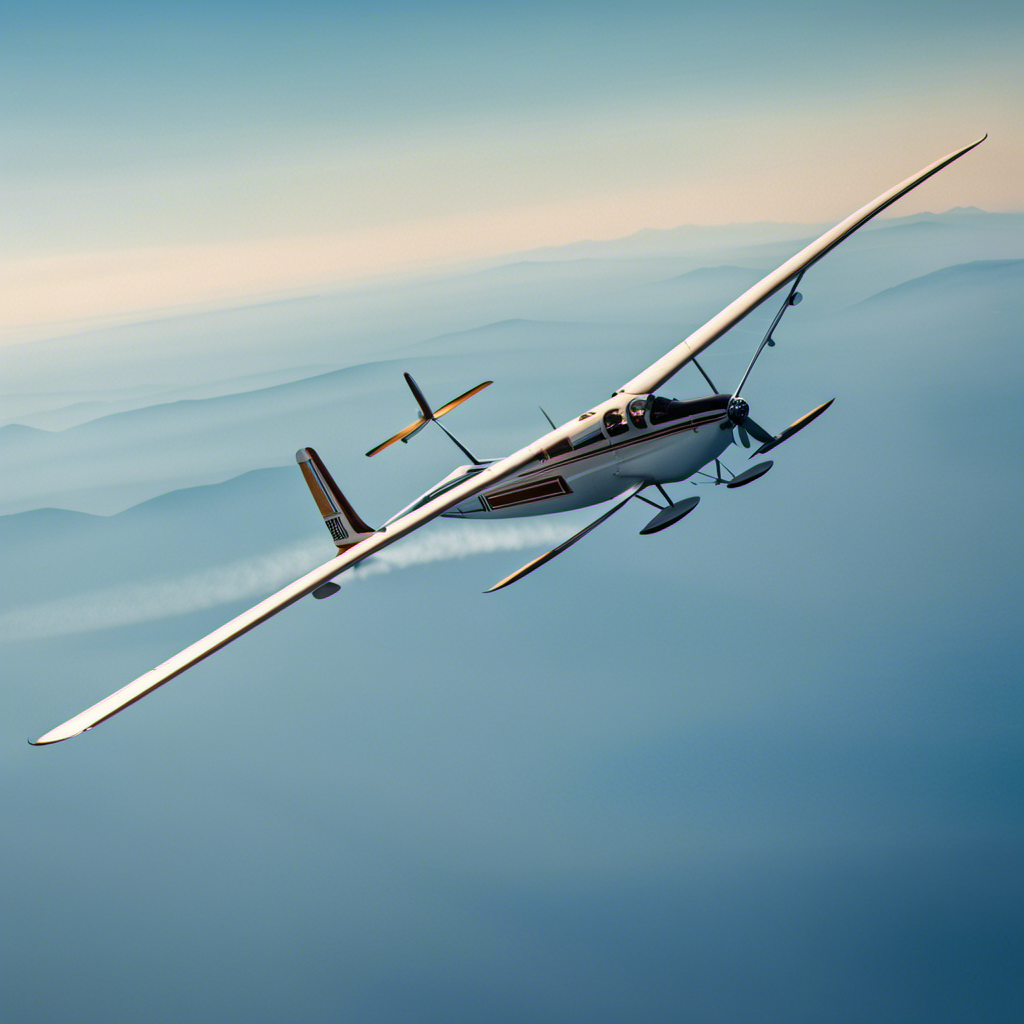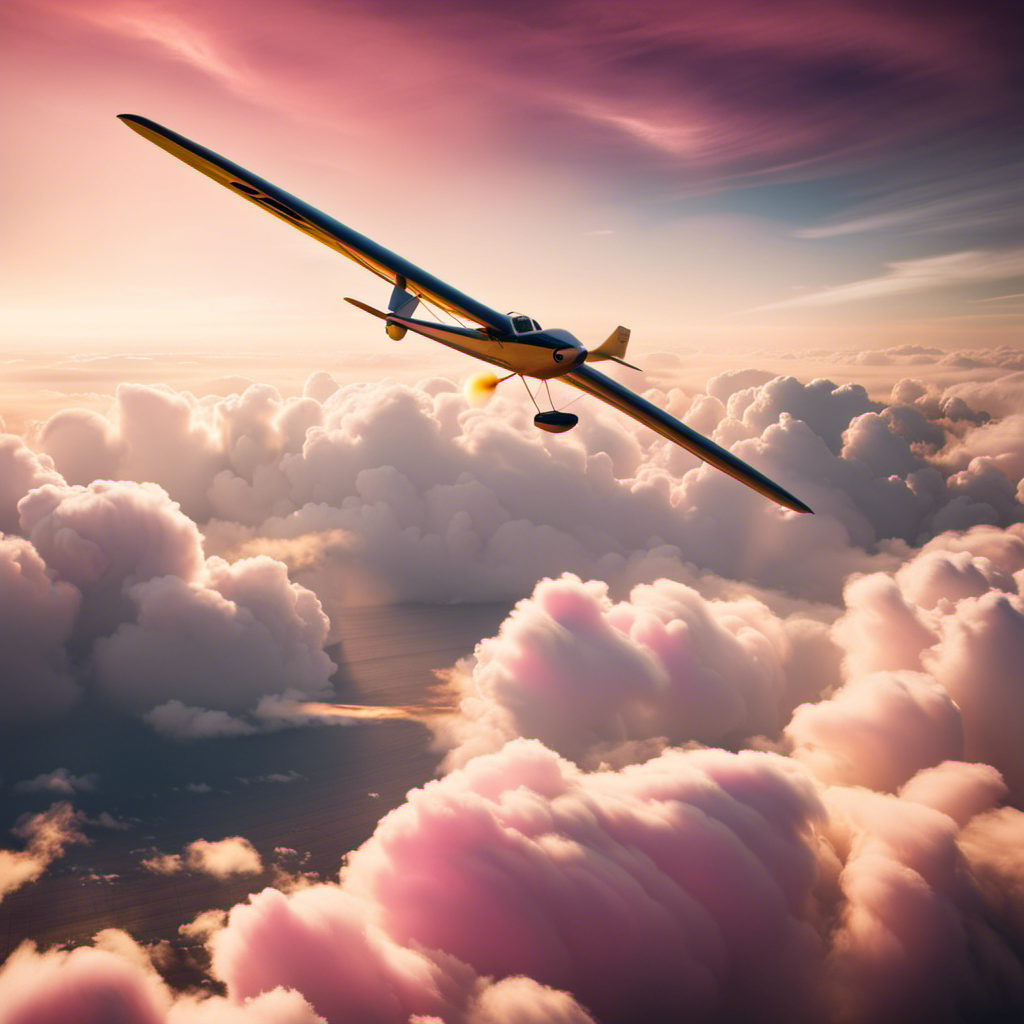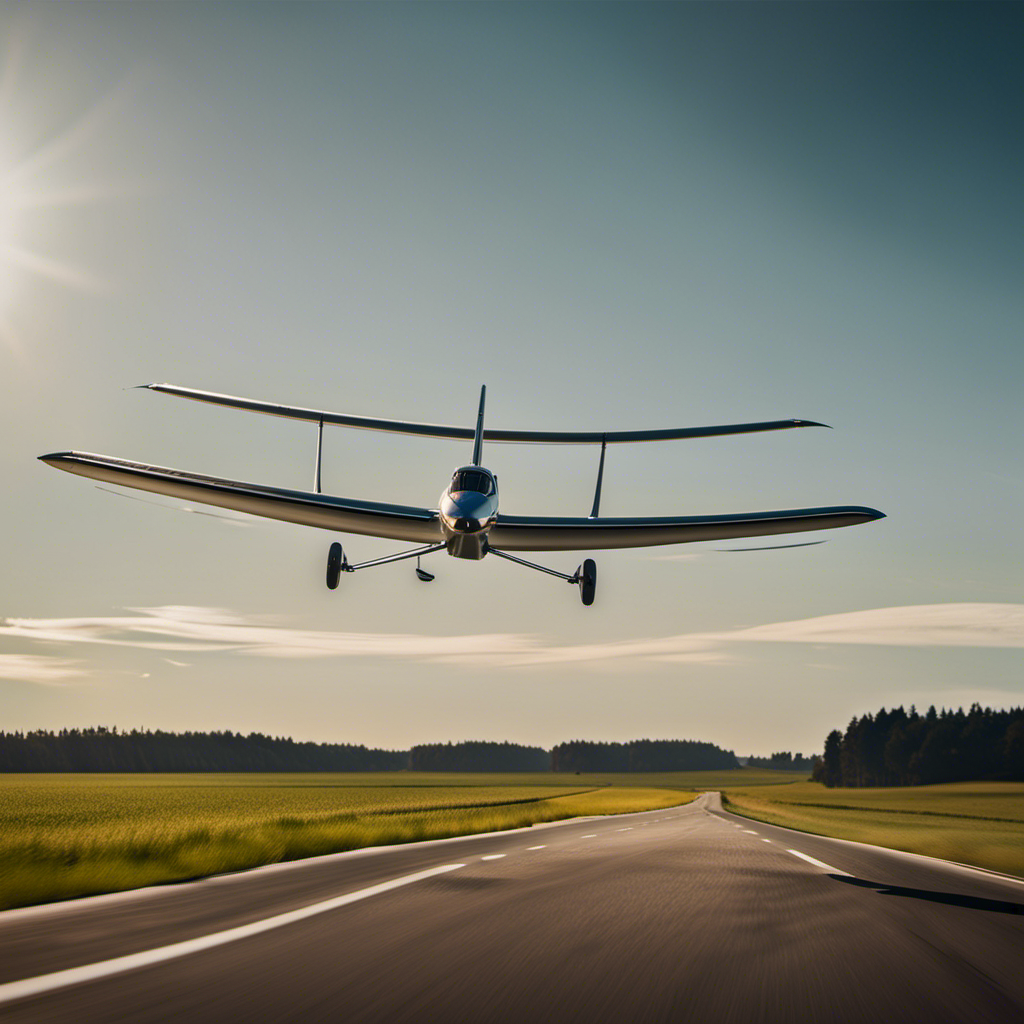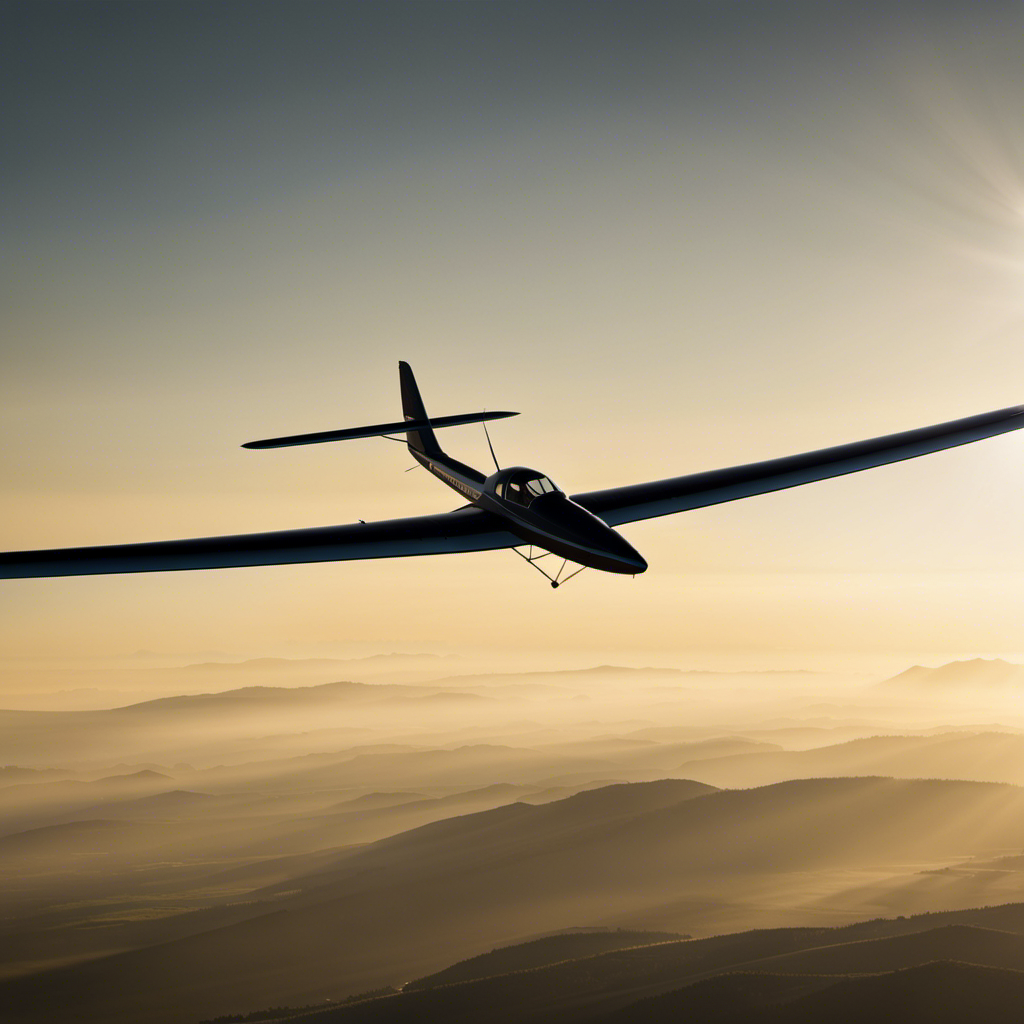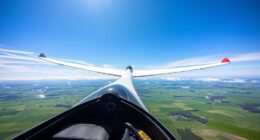As I soar through the sky, carried by the power of the wind, it recalls the exhilarating experience of being towed in a glider.
In this detailed guide, I will take you on a journey to discover the ins and outs of this exhilarating activity. From the equipment involved to the safety procedures, we will explore every aspect of glider aerotow.
So fasten your seatbelt and prepare for an adventure like no other. Let’s dive into the world of glider aerotow!
Key Takeaways
- Glider aerotow allows for higher altitudes and longer soaring time.
- Proper equipment, such as a tow plane, tow rope, and release mechanism, is essential for glider aerotow.
- Preparing for a glider aerotow involves checking the glider and tow rope, establishing clear communication, and being familiar with the towplane’s capabilities.
- During the takeoff and in-flight, maintaining control, monitoring towline tension, and adhering to safety protocols are crucial for a successful glider aerotow.
What is Glider Aerotow?
Glider aerotow is a method of launching a glider using a powered aircraft. It offers several benefits compared to other launching techniques.
Firstly, it allows the glider to reach higher altitudes, which provides more time and space for soaring. Secondly, glider aerotow allows for longer flights as the powered aircraft can tow the glider to distant locations. This opens up opportunities for cross-country flights and exploration of new areas. Additionally, glider aerotow techniques enable gliders to be launched quickly and efficiently, reducing the wait time between flights.
To perform a glider aerotow, a specialized tow rope is attached to the glider and the powered aircraft. The glider pilot must communicate with the tow pilot to ensure a smooth takeoff. As the powered aircraft accelerates down the runway, the glider is lifted into the air. The pilot then maneuvers the glider to maintain position behind the tow plane. Once the desired altitude is reached, the glider pilot releases the tow rope, allowing the glider to continue its flight independently.
Transitioning into the subsequent section about the equipment involved, it is essential to understand the key components required for a successful glider aerotow.
The Equipment Involved
The equipment involved in aerotow operations includes a tow plane, tow rope, and release mechanism. These are the essential gear that make glider aerotows possible. The tow plane, typically a propeller-driven aircraft, is responsible for pulling the glider into the air. It must have enough power and lift capacity to safely tow the glider. The tow rope, made of strong synthetic material, connects the tow plane to the glider. It needs to be long enough to provide sufficient distance between the two aircraft, but not so long that it becomes difficult to control. The release mechanism is a crucial component that allows the glider to detach from the tow plane once it reaches the desired altitude.
| Tow Plane | Tow Rope | Release Mechanism |
|---|---|---|
| Power | Strength | Reliability |
| Lift | Length | Precision |
| Capacity | Control | Safety |
| Propeller | Material | Functionality |
| Efficiency | Durability | Ease of Use |
Understanding the different pieces of equipment used in glider aerotow operations is important for pilots and enthusiasts alike. It ensures the safety and efficiency of the process. Now, let’s move on to preparing for a glider aerotow, where we will explore the necessary steps to get ready for this exhilarating experience.
Preparing for a Glider Aerotow
To get ready for a glider aerotow, you’ll need to ensure you have the proper equipment and knowledge. Glider aerotow techniques require precision and attention to detail, so it’s crucial to follow an aerotow checklist to ensure a safe and successful flight. Here are five important steps to consider:
-
Check the glider’s airworthiness: Inspect the glider thoroughly to ensure it is in good condition, paying close attention to the control surfaces, cables, and connectors. Any signs of wear or damage should be addressed before the flight.
-
Verify tow rope integrity: Examine the tow rope for any signs of fraying or weakness. It’s essential to use a high-quality and properly rated tow rope to ensure a secure connection between the glider and towplane.
-
Communicate with the tow pilot: Establish clear communication with the tow pilot to discuss the flight plan, signals, and emergency procedures. This ensures both pilots are on the same page throughout the aerotow.
-
Familiarize yourself with the towplane: Understand the towplane’s capabilities, including its engine power and climb rate. This knowledge allows you to anticipate its behavior during the aerotow.
-
Prepare for emergency scenarios: Familiarize yourself with emergency procedures, such as a rope break or loss of communication. Being prepared for unforeseen circumstances will help you handle them safely and effectively.
With these preparations complete, it’s time to move on to the next phase: the takeoff. The glider aerotow begins once the towplane starts rolling down the runway, and the glider starts to lift off.
The Takeoff
Once you’re in position and the towplane begins to accelerate, maintain a steady grip on the controls and prepare to smoothly lift off. As the towplane accelerates, it is crucial to keep the glider aligned with the centerline of the runway. Apply slight back pressure on the controls to keep the glider’s nose slightly above the horizon. This helps maintain a positive angle of attack and ensures a smooth lift-off.
During the initial stages of the takeoff roll, it’s important to monitor the towline tension. The towline should be taut but not excessively tight. Excessive tension can put stress on the glider’s airframe and compromise its integrity. As the speed increases, the glider will begin to generate lift, and the towplane will start to rotate. At this point, smoothly follow the towplane’s pitch motion while maintaining a constant pitch attitude.
Once airborne, maintain a safe distance from the towplane while staying in formation. This is crucial for safety and to avoid any potential collisions. As you gain altitude, keep a lookout for other aircraft and be prepared to release from the towline if necessary.
Transitioning into the subsequent section about ‘in-flight considerations,’ it is important to remain vigilant and aware of your surroundings.
In-flight Considerations
Transitioning into the in-flight phase, you should maintain a constant scan of the sky and be attentive to potential traffic. This is crucial for safe glider aerotow operations. Here are four important considerations to keep in mind during the in-flight phase:
-
In-Flight Communication: Clear and effective communication between the glider pilot and the tow pilot is essential. Properly coordinating maneuvers, speed adjustments, and any changes in the flight plan ensures a smooth and safe flight.
-
Weather Conditions: Monitoring weather conditions is vital for a successful aerotow. Strong crosswinds, gusty winds, or turbulent air can impact the stability of both the tow plane and the glider. Stay updated on weather reports and be prepared to adapt accordingly.
-
Traffic Awareness: Maintain a vigilant lookout for other aircraft in the vicinity. This includes both powered aircraft and other gliders. Stay aware of the airspace around you to avoid potential collisions.
-
Aerotow Techniques: Understanding and applying proper aerotow techniques is crucial. Maintaining the correct position, tension on the towline, and making coordinated turns are all important skills to master for a successful aerotow.
As the in-flight phase progresses, the next consideration is landing after an aerotow.
Landing after an Aerotow
When you’re approaching the landing phase after an aerotow, it’s important to maintain a stable descent and carefully follow the instructions given by the tow pilot. As you begin your descent, you need to be aware of the wind conditions and how they may affect your landing. The wind direction and strength will determine your approach and landing techniques. If the wind is strong, it may be necessary to fly a steeper approach to maintain control and prevent being blown off course. Conversely, if the wind is light, a shallower approach may be more appropriate.
Emergency landings are a possibility during the landing phase. If you encounter an emergency, it is crucial to remain calm and assess the situation quickly. Depending on the severity of the emergency, you may need to perform an immediate landing or execute an emergency procedure. In either case, it is important to prioritize safety and follow the established protocols.
Transitioning to the next section, safety and emergency procedures are vital aspects of glider aerotow operations. Ensuring that pilots are well-trained in emergency procedures and that the glider is equipped with necessary safety equipment is essential. By being prepared and knowledgeable, pilots can confidently handle any unexpected situations that may arise during an aerotow.
Safety and Emergency Procedures
Safety and emergency procedures are crucial in glider aerotow operations. Pilots must be well-prepared for any unexpected situations that may arise. As a glider pilot, I understand the importance of following these protocols to ensure a safe and successful flight.
Here are four key safety procedures and emergency protocols that every glider aerotow pilot should be familiar with:
-
Pre-flight checks: Before takeoff, it is essential to conduct a thorough inspection of the glider and tow aircraft. This includes checking control surfaces, verifying proper connections, and ensuring the tow rope is securely attached.
-
Communication: Clear and effective communication between the glider and tow aircraft pilot is vital during the entire aerotow operation. Standard radio procedures should be followed to relay important information and make any necessary adjustments.
-
Emergency release: In the event of an emergency or abnormal situation, the glider pilot must be ready to release the tow rope quickly. This can be done by activating the emergency release mechanism, which detaches the glider from the tow aircraft.
-
Emergency landing procedures: If an emergency landing is necessary, the glider pilot should be familiar with the proper techniques and procedures. This includes selecting a suitable landing area, maintaining control of the glider, and executing a safe touchdown.
By adhering to these safety procedures and emergency protocols, glider aerotow pilots can minimize risks and ensure a safe flying experience.
Now, let’s explore the advantages and disadvantages of glider aerotow operations.
Advantages and Disadvantages of Glider Aerotow
Transition: Now that we have covered safety and emergency procedures in glider aerotow, let’s move on to discussing the advantages and disadvantages of this method.
Current Subtopic: Advantages and Disadvantages of Glider Aerotow
Glider aerotow offers several benefits and drawbacks. One of the main advantages is the ability to reach higher altitudes compared to other launch methods. This allows glider pilots to access stronger thermal currents and increase their chances of staying aloft for extended periods.
Additionally, aerotow launches are relatively quick and efficient, allowing for more flight time and increased training opportunities.
However, there are also some drawbacks to consider. Glider aerotow requires the use of a powered aircraft, which means additional costs for fuel and maintenance. Furthermore, the reliance on a tow aircraft can limit the flexibility of glider pilots, as they must coordinate their flights with the availability and schedule of the tow plane.
Additionally, the aerotow procedure itself can be challenging, especially for novice glider pilots, as it requires precise coordination and communication between the glider and tow aircraft.
Transition: Now that we have explored the pros and cons of glider aerotow, let’s delve into the essential aspects of training and certification required for this exhilarating flying technique.
Training and Certification
To become proficient in glider aerotow, you’ll need to undergo proper training and obtain the necessary certification. Training programs are essential to ensure the safety and competence of pilots engaging in glider aerotow operations. These programs typically consist of a combination of ground instruction and flight training, covering topics such as aerodynamics, aircraft systems, emergency procedures, and communication protocols.
In order to meet the regulatory requirements for glider aerotow, pilots must complete a specified number of flight hours and pass both written and practical exams. The exact requirements may vary depending on the country or region, but the goal is always to ensure that pilots have the necessary knowledge and skills to safely operate gliders in aerotow operations.
Training programs often include hands-on experience, allowing pilots to practice their skills in real-world scenarios. This may involve simulated emergencies, communication exercises, and supervised flights with experienced instructors. By completing these programs and obtaining the necessary certification, pilots can demonstrate their competence and commitment to safety in glider aerotow operations.
With proper training and certification, pilots can become part of the glider aerotow community, participating in events and competitions across the globe. These communities provide opportunities for pilots to further enhance their skills, share experiences, and connect with other aviation enthusiasts. From local club gatherings to international competitions, glider aerotow events offer a vibrant and supportive environment for pilots to engage in their passion for soaring.
Transitioning to glider aerotow communities and events, pilots can take their skills to the next level, immersing themselves in a world of shared knowledge and exhilarating experiences.
Glider Aerotow Communities and Events
Pilots who join glider aerotow communities and events can connect with other aviation enthusiasts and immerse themselves in a vibrant and supportive environment. These communities provide an excellent platform for pilots to learn and improve their glider aerotow techniques through various activities and competitions.
Glider aerotow competitions are a highlight of these events. Pilots compete against each other to showcase their skills and push the boundaries of glider aerotow. These competitions test their ability to coordinate with the tow pilot, maintain proper positioning within the aerotow formation, and execute smooth releases.
Participating in glider aerotow events also offers a unique opportunity to learn from experienced glider pilots. These seasoned aviators are often willing to share their knowledge and insights, helping newcomers refine their techniques and improve their performance. The supportive nature of these communities fosters camaraderie and encourages pilots to push themselves to new heights.
In addition to the competitive aspect, glider aerotow events provide a platform for pilots to network and build connections within the aviation community. These connections can lead to new opportunities, such as mentorship programs, sponsorship deals, or even job prospects in the aviation industry.
Overall, glider aerotow communities and events offer pilots a chance to not only improve their skills and compete in thrilling competitions but also to connect with fellow aviation enthusiasts and develop lasting relationships.
Frequently Asked Questions
How long does it typically take to complete a glider aerotow from start to finish?
On average, a glider aerotow takes about 15 to 20 minutes to complete, depending on various factors such as wind conditions and the distance between the aerotow aircraft and the glider. Safety precautions and equipment requirements are essential for a successful and secure aerotow operation.
Are there any weight restrictions for passengers on a glider aerotow?
There are weight restrictions for passengers on a glider aerotow to ensure safety. It is important to follow these restrictions to maintain the balance and stability of the glider during the flight.
Can glider aerotows be done in all weather conditions?
Weather conditions greatly impact glider aerotows. Strong winds, turbulence, and low visibility can make aerotows unsafe or impossible. Additionally, the duration of glider aerotows may be affected. Communication methods are crucial to ensure the safety of all involved and prevent detachment during the aerotow.
Is it possible for a glider to become detached from the tow aircraft during an aerotow?
Glider detachment during an aerotow is a rare occurrence, but safety precautions are in place to prevent it. With proper training, maintenance, and communication, the risk is minimized, ensuring a smooth and secure flight experience.
Are there any specific hand signals or communication methods used during a glider aerotow?
During a glider aerotow, hand signals and communication methods are crucial for ensuring a safe and coordinated flight. Pilots use hand signals to indicate speed, direction, and release. Radio communication is also used for clear and concise instructions.
Conclusion
In conclusion, glider aerotow is a thrilling and efficient method of launching gliders into the sky. It requires careful preparation, using specific equipment and following safety procedures.
The takeoff is a crucial moment that requires precise coordination between the glider and the towplane. In-flight, pilots must consider factors like wind conditions and thermals to maximize their flight time. Safety and emergency procedures are vital to ensure a smooth and secure flight.
Glider aerotow offers many advantages, such as extended flight durations, but also has its disadvantages. Training and certification are necessary to participate in this exciting activity. Joining glider aerotow communities and events is a great way to connect with fellow enthusiasts and share experiences.
So, strap in and get ready to soar through the skies like a bird!
Orion, better known as “Jetstream,” is the voice that brings the stories of the skies to life. His fascination with aviation began at a young age, sparked by his father’s tales of flying and adventure. Orion’s journey into the world of gliding was serendipitous, and from the moment he took his first glider flight, he knew he had found his calling.
